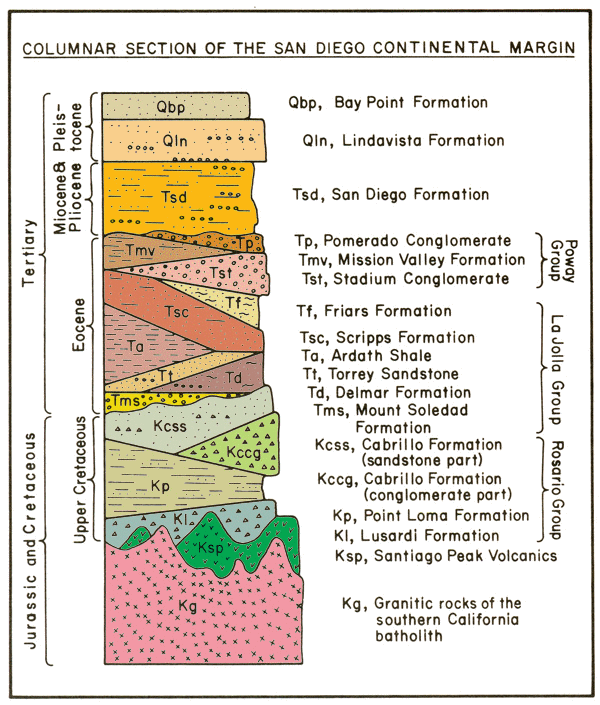
 Tourmaline Surfing Park’s cliffs expose six different geological formations – the Point Loma Formation, Cabrillo Formation, Mt. Soledad Formation, Scripps Formation, San Diego Formation, and Bay Point Formation – which are from four different geological ages – the Cretaceous Period, Eocene Epoch, Pliocene Epoch, and Pleistocene Epoch. This earthcache is meant to be a tour of all the different formations from youngest to oldest.
Tourmaline Surfing Park’s cliffs expose six different geological formations – the Point Loma Formation, Cabrillo Formation, Mt. Soledad Formation, Scripps Formation, San Diego Formation, and Bay Point Formation – which are from four different geological ages – the Cretaceous Period, Eocene Epoch, Pliocene Epoch, and Pleistocene Epoch. This earthcache is meant to be a tour of all the different formations from youngest to oldest.
Bay Point Formation
N 32° 48.270 W 117° 15.694
The Bay Point Formation is visible at the top of the cliff at the coordinates. It is the youngest formation exposed at Tourmaline Beach. It was deposited on top of an underwater terrace during the Pleistocene Epoch (.01-1.8 million years ago). Consisting of cobbles, pebbles, sand, and mud, this formation is weakly cemented and erodes very easily. It also contains many different types of fossils.
San Diego Formation
N 32° 48.270 W 117° 15.694
Just below the Bay Point Formation is the San Diego Formation. It was formed in beach environments during the Pliocene Epoch (1.8-5.3 million years ago) and consists of conglomerate (consolidated rocks) overlain by friable sandstone. At the coordinates you can see the friable sandstone. The reason it’s friable is because it’s geologically young and not old enough to be compacted and cemented into hard rock. It also contains an abundance of fossils such as scallops (Patinopecten healeyi, Flabellipecten sternsii, Argopecten invalidus, Argopecten subdolus, and Pecten bellus), oysters (Ostrea vespertina), sand dollars (Dendraster ashleyi), and snail shells (Opalia varicostata). There have been 24 different species of scallops documented in the San Diego Formation. The first logging requirement is that you find a fossil, take a picture of it, and measure it.
At N 32° 48.350 W 117° 15.771, north of the parking lot, the conglomerate is visible. The conglomerate is composed of rhyolite, breccias, and metamorphic rocks. The tilting of the conglomerate compared to the formation below it is due to the Rose Canyon Fault. There is also an unconformity between the conglomerate and the underlying Mt. Soledad Formation that spans 43 million years. An unconformity is a discontinuity in a rock sequence indicating an interruption of sedimentation, commonly accompanied by erosion of rocks below the break. The second logging requirement is to take a picture with you and/or your gps at the unconformity.
Scripps Formation
N 32° 48.370 W 117° 15.785
Below the conglomerate and at the coordinates is the Scripps Formation which was formed in submarine fan and tidal flat environments during the Eocene Epoch (33.7-54.8 million years ago). It is composed of sandstone, mudstone, and siltstone. This formation as well as the Mt. Soledad Formation contains gypsum. This gypsum formed from groundwater leaching the soluble parts of the rock and precipitating in the numerous cracks in the formation. The third logging requirement is to find some gypsum, take a picture of it, and measure its width.
Mt. Soledad Formation
N 32° 48.444 W 117° 15.850
At the coordinates is the Mt. Soledad Formation. It was formed during the Eocene Epoch as channel fill in beach environments. It is composed of conglomerate and sandstone.
Cabrillo Formation
N 32° 48.484 W 117° 15.928
At the coordinates is the conglomerate and sandstone of the Cabrillo Formation which formed during the Cretaceous Period (65-144 million years ago) in shallow marine conditions. The dip in the conglomerate is caused by a submarine fan filling a submarine canyon. In this formation, the conglomerate is overlain by sandstone. The fourth logging requirement is to find a conglomerate in the Cabrillo Formation in the cliffs, take a picture of it, and measure it.
Also, there are exposures of the shale of the Point Loma Formation which formed during the Cretaceous Period near the tip of False Point.
Logging Requirements:
Send me an email with the answers to the following questions:
1. Find a fossil in the San Diego Formation (N 32° 48.270 W 117° 15.694), take a picture of it, and measure it.
2. Take a picture with you and/or your gps at the unconformity (at the very top of the cliff!) (N 32° 48.350 W 117° 15.771).
3. Find some gypsum in the Scripps Formation (N 32° 48.370 W 117° 15.785) or Mt. Soledad Formation (N 32° 48.444 W 117° 15.850) in the cliffs, (it won't be thicker than an inch!) take a picture of it, and measure its width.
4. Find a conglomerate (a rounded rock/cobble) in the Cabrillo Formation (N 32° 48.484 W 117° 15.928) in the cliffs, take a picture of it, and measure it.
EDIT: As photos are optional, it is acceptable to describe each of the features in your email to me.
Please Note:
1. You must answer all the questions in your email to me and post all picture(s) with your log.
2. Your logging this cache and sending me the email should happen at around the same time.
3. Begin your email with the name and geocaching code of this Earthcache, your name(s), and the number of people in your group.
Failure to comply with the above will result in your log being deleted!
The above information was compiled from the following sources:
1. The Rise and Fall of San Diego by Patrick L. Abbott, 1999
2. Tourmaline Beach, SDSU Department of Geological Sciences, 2010
3. Self Guided Field Trip to Tourmaline Surfing Park, Grossmont College, 2007
